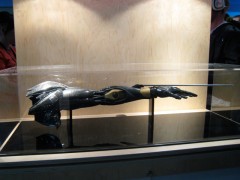Welcome to the home of PAX Prime, the Washington State Convention Center in lovely Seattle, WA!
This was where we spent much of our weekend—attending panels, checking out the cosplayers, and going hands-on with upcoming games in the massive Expo Hall(s). Actually, we didn’t get to play as much as we liked, since the lines for popular titles, most memorably Star Wars: The Old Republic, were incredibly long. As with PAX East, panels were our main priority.
However, we did watch a lot of games being played, in all sorts of genres, and checking out the booths themselves was also enjoyable. The booth that was hardest to ignore was the one for FireFall. They were a major sponsor of the show this year by the looks of things; in addition to the huge booth, there was an animatronic display near the Expo Hall entrance (Prototype 2‘s booth was also in that area), FireFall branding on the PAX swag bag, ads on the escalators, and more. Clearly the goal of FireFall‘s publishers was to get the name and look of the game firmly entrenched in our minds. As for the game itself, I didn’t get to play it, but it looks like an MMO action game of some sort. It is also highly derivative in its aesthetics—even the logo is StarCraft-ish.
Bethesda’s booth was impressive as well, thanks to a large dragon that loomed over the area dedicated to The Elder Scrolls V: Skyrim. Bethesda also had some Prey 2 stuff as well as Rage in playable form. Save for some canned, stiff animation, Rage looks absolutely stunning, though I seriously doubt that my computer will be able to run it.
Although I didn’t see anything of the game itself, the BioShock Infinite display was marvelous, and the most unique thing I saw on the show floor. There were a few other standouts scattered about, including a plant-like thing for Rift, the inflatable Normandy hovering over Mass Effect 3, the secret society quiz terminals for The Secret World, and Sega’s Rise of Nightmares prison cell. For the Kinect version of Just Dance 3, Ubisoft had a simple stage, but dancing con-goers added the extra hook.
Some people tend to forget this, but geeky non-video games have a large presence at PAX as well. There were a lot of areas dedicated to board, pen-and-paper, and trading card gaming, including a whole branch of the Expo Hall. Publishers of such games had their own booths, plus there were a handful of booths selling games, gaming accessories such as dice, and even dedicated pieces of gaming and collection furniture.
Other vendors included Seattle import specialist Pink Gorilla (which had plenty of import games at their booth, but strangely, no PS2 ones) and artbook localizer Udon, who shared space with comic book publisher Oni Press. There was also a booth selling general anime merchandise, but I was immediately turned off once I noticed that the Nendoroids and certain other items were bootlegs. Square Enix had Deus Ex: Human Revolution Play Arts Kai figures on display at their booth but, much to my dismay, the company wasn’t selling any of their collectables at the show.
Upstairs was a sort of annex to the main hall, where indie game publishers and lesser-known PC hardware manufacturers lived. This room saw a lot of traffic thanks in large part to the presence of Mojang, aka the Minecraft developer. Meanwhile, there was the Handheld Lounge, a land of beanbag chairs occupying hall space on two floors, and sponsored by Nintendo. Although Ninty had a large booth in the Expo Hall, they showed additional games here, including two upcoming Kirby games and Dragon Quest Monsters. Unfortunately, I had somehow forgotten to take photos of both areas.
I could go on, but to describe everything I saw would double the length of this post. Therefore, I’ll close out with brief impressions of the games I actually played.
Kirby Mass Attack for the DS is one of the most unique platformers I have seen in some time. The entire game is played with the stylus, and up to ten Kirbies can be controlled at once. These Kirbies are obtained by eating food found on the field (Maxim Tomatoes, as expected, are the “strongest” of these foods), and some areas can only be reached with a certain number of Kirbies. Though the game is being released very soon, the copies available for play in the Handheld Lounge were in Japanese. I guess the localization wasn’t ready for the show.
Kirby’s Return to Dream Land and Fortune Street were the only Wii games shown in the Handheld Lounge. The former supports up to four players at once and is as madcap as one expects from the studio that also makes the Smash Bros. games; unfortunately, the other characters aren’t as versatile or as necessary as Kirby, which is this game’s greatest weakness. Fortune Street is the first of the Itadaki Street games to be released outside of Japan, but I don’t think it will do very well since, for a board-style party games, it is way too complicated.
Pokedex 3D is neat, and I’ll probably download it once/if I get a 3DS. Dragon Quest Monsters: Joker 2 is about what I expected, which is to say I’m still planning on buying it.
At the Microsoft booth, I played around a little with Sonic CD, which thankfully has an option to turn on the original graphics, since the “new” ones look horrible. My husband and I also tried out Trine 2, which looks and plays very well, and Pinball FX 2 which is great save for the fact that the balls blend into the playfield a bit too much.
The main indie game I tried at the show was Path of Exile, a Diablo clone with not much to it. The user interface reminded me of Torchlight‘s, but having the health and mana meters on opposite sides of the screen was inconvenient.
That’s about it for the Expo Hall. In tomorrow’s post, I’ll talk about the panels and certain other events which I attended.





















